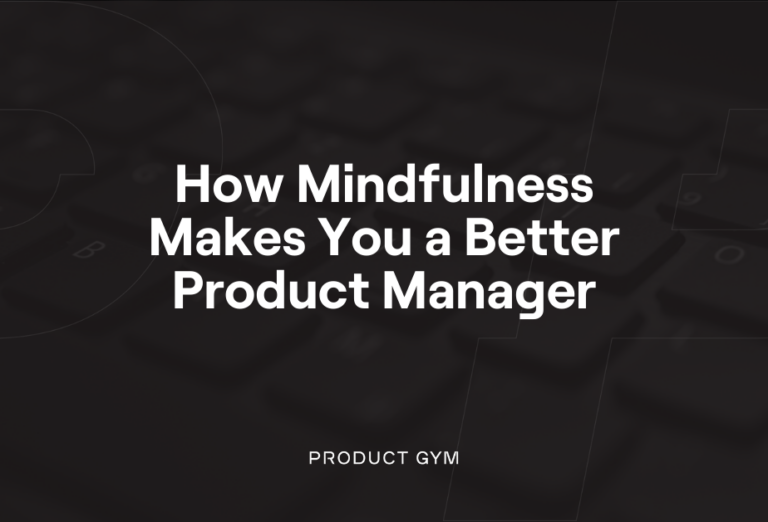Imagine starting off every Monday morning with a clear, mindful head that delivers a high quality of work. Now, imagine seeing that same result with your entire staff. That is exactly the result Mike Del Ponte, creator of Soma Water saw when he implemented office meditation sessions every morning. He encouraged his staff to focus on their most pressing work from 10 am until lunchtime to capitalize on that feeling.
Del Ponte is not the only one implementing and seeing the results of mindful meditation. Companies like Apple, Google, and Nike have noted that mindfulness provides a number of well-known benefits, such as improved creativity, productivity, and well-being. As a product manager or product owner, mindfulness is particularly helpful.
Why Office Meditation?
Meditation is a practice that cultivates mindfulness. Mindfulness means paying attention to the present moment, to what is actually happening. It helps us become more aware of what we think and feel, and how we are — content, tense, relaxed, stressed, happy, angry, indifferent, restless, worried, or calm. In the fast-paced context of an office, meditation can allow us to address the present state we are in and respond to our surroundings in a more productive way, thanks to that increased mindfulness. You could argue, surely all of us already are aware of who and how we are at any given moment. But, are we fully aware?
Office Meditation and Product Management
Product managers are generalists that carry out diverse tasks, from shaping the product strategy to crafting user stories. We could feel powerless, restless and definitely stressed out and that can then come across in our work ethic and interactions. Office meditation, and the mindfulness that follows, helps us to become aware of how we really are — allowing us, from an early start, to adapt to the working environment of a product manager.
Product managers have to embody an innate sense of empathy for the product user. There has to be a genuine interest in solving the problem or providing a benefit. This is where mindfulness meditation comes into play: it strengthens our capacity to empathize with others and ourselves. It teaches us to be calm, open and non-judgemental. These are qualities that are extremely useful when interacting with users, customers, and internal stakeholders.
How to Practice Mindfulness
Now, office meditation isn’t the only way to practice mindfulness. Just following the general rules of life that dictate conscious actions and behavior can help achieve mindfulness.
Take Your Time
For example, don’t rush. As Product Managers and owners, we are prone to overcommitting and taking on too much work. With so many responsibilities, it seems logical to work as hard and as fast as possible. But rushing from one task to the next and from one meeting to another is likely to reduce your productivity. As the old saying goes: Haste makes waste.
Be Engaged
Do one thing at a time, and don’t multi-task. Be present and fully engaged in what you do — or don’t do it. A thing worth doing is worth doing well, as the old saying goes, even if it’s difficult and challenging. Furthermore, remember to take proper breaks. It can be tempting to keep busy. There is usually plenty of work to do for us product people; being busy can make us feel useful and wanted, and getting things done can be exciting and rewarding.
We are stuck in a work bubble and in danger of running out of energy and creativity. I find it impossible to come up with new ideas and be creative when my head is full of all the other tasks I still need to do. Creativity needs space.
Keep an Open Mind
Keep an open mind. For example, when talking to users or customers, make an effort not to judge anything you hear. Listen patiently and calmly. Take in whatever is said — no matter if you agree, disagree, or are indifferent. While this sounds easy, I find that listening with an open mind can be challenging: I sometimes catch myself evaluating and judging what has been said, or getting bored and impatient. I then have to remind myself to relax, suspend judgment, and pay attention to the conversation. As an added benefit, this practice helps to neatly separate gathering data from analyzing it, which is desirable to maximize learning.
Think Positive
Having a closed mind can result in a negative attitude. Therefore, be positive. A great way to foster a positive attitude is to cultivate gratefulness. No matter how challenging things are, you should look for the positives, the healthy traits in people (without ignoring unhealthy habits and wrong behavior). Developing a positive attitude will increase your well-being and make you an even more likable person.
How to Practice Office Meditation
All of these actions and behaviors can result in mindfulness, but it may be difficult to tap into these actions and behavior. Office meditation nicely supports mindfulness practice by acting as a vehicle. A common meditation technique is to patiently and gently observe the breath. This increases awareness teaches patience and highlights thoughts and feelings that come up and take us away from the breath. I certainly find meditation very helpful and recommend that you try it, or if you are a practitioner, keep it up.
While meditation can be pleasant and enjoyable, it’s certainly not about escaping from reality. To experience things for what they are, to become more aware of our thoughts, emotions, and mental states. Don’t strive for a pleasant meditation experience. Accept whatever you experience, even if it’s unpleasant mental states like restlessness, tension, or aversion. Only if we aware of what’s happening, what we think and feel, can we do something about it. What’s more, I find that my mind tends to settle and become calmer and more peaceful after a few minutes; negative thoughts and emotions tend to weaken and often disappear when I acknowledge but don’t engage in them.
Make sure that you sit comfortably but upright when meditating. Sitting on the ground on a cushion works best for me. While it may be tempting to lie down, avoid this position. It is all too easy to fall asleep once you’ve started to relax, particularly when you meditate in the evening like I often do. Another posture that works well for me particularly for shorter meditations during the day is standing still. To maximize its benefits, meditation should be done regularly. Like any exercise, regular short meditation sessions tend to be better than an occasional, long one.
Be Mindful
Mindfulness is a root construct. It touches on everything and can have a real impact across a range of human functioning. Mindfulness helps people think, feel, and act better at work. To sustain your mindfulness, in addition to being cognizant of the action and behaviors outlined above to strive for meditation as a practice. Make it part of your daily routine. Meditate in the morning, lunchtime and/or evening, depending on what is best for you. Start with 10 minutes and see how that works for you.
Are you struggling to cultivate the skills you need to succeed in your product management job hunt? Take a look at our free training on product manager job-hunting strategies: we want to see you to succeed! If you’re looking to kick-start your career, then give us a call to learn more.




